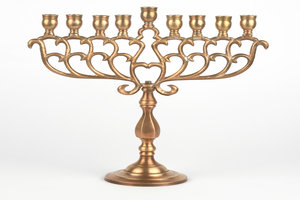Last week, in Wilderness Instructions, Part 6, we learned that the table of acacia wood, with its showbread drizzled with Frankincense, serves as an important reminder to us today of God’s provision, sustenance, hospitality, and His ability to guide us towards purity and renewal.
Our lesson today takes us to Exodus 25:31-36, the construction of “The Lampstand”: “You shall also make a lampstand of pure gold…” (Ex. 25:31a)
Unlike the Ark of the Covenant and the table for the showbread, the lampstand was to be made, not of wood overlaid with gold, but of pure gold. And God was quite specific about its design:
• It was to be one piece: “the lampstand shall be of hammered work. Its shaft, its branches, its bowls, its ornamental knobs, and flowers shall be of one piece.” (vs. 31b NKJV);
• There were to be branches on the lampstand: “And six branches shall come out of its sides: three branches of the lampstand out of one side, and three branches of the lampstand out of the other side.” (Vs. 32).
• On the top there were to be three almond blossom-shaped bowls: “Three bowls shall be made like almond blossoms on one branch, with an ornamental knob and a flower, and three bowls made like almond blossoms on the other branch, with an ornamental knob and a flower–and so for the six branches that come out of the lampstand.” (Vs 33 NKJV);
• On the lampstand itself, there were to be more bowls: “On the lampstand itself four bowls shall be made like almond blossoms, each with its ornamental knob and flower.” (Vs 34 NKJV)
• Besides the ornamental flowers, there were to be knobs: “And there shall be a knob under the first two branches of the same, a knob under the second two branches of the same, and a knob under the third two branches of the same, according to the six branches that extend from the lampstand.” (Vs. 35)
Quite impressive, isn’t it?
And what was the purpose of this elaborate lampstand?
To hold up lamps! “You shall make seven lamps for it…” (vs. 38a NKJV)
The lamps were to be set in a special way: “and they shall arrange its lamps so that they give light in front of it.” (Vs 38b NKJV. See also Numbers 8:2).
Thus, the lampstand was practically designed to be a source of light for the rest of the tabernacle, to cast light upon the Table of the Showbread, the Altar of Incense, and the veil.
The lamps were to be kept burning continually, and their oil was to never run out: “Command the Israelites to bring you clear oil of pressed olives for the light so that the lamps may be kept burning continually.” It has also been suggested that the fact that the lamps were to be kept burning perpetually was to be a reminder of the burning bush through which God manifested Himself to Moses.**
Through the ages this Lampstand has become known as the “Menorah”, and it is considered to be a symbol of Judaism at large. Jesus used the symbols of seven Menorahs in the revelations He gave to John (See Rev. 1:12) as an indicator of the fact that the message was for the global church at large.
These are all interesting facts, but what does it mean to us today? Why do we need to read about the lampstand of gold, and what place does it play in our heart-temples?
First of all, let’s remember that throughout Scripture, oil is often used as a symbol of the Holy Spirit (See Matthew 25). This is our first lesson today. We are nothing without God’s Spirit!
Secondly, just as Israel was instructed to never let the oil run out, we, too, must always have the refreshing of God’s Spirit in our lives and churches. Otherwise we can quickly be overtaken by spiritual darkness: “And while they went to buy, the bridegroom came, and those who were ready went in with him to the wedding; and the door was shut. Afterward the other virgins came also, saying, ‘Lord, Lord, open to us!'” And like the 5 foolish maidens, that it will not be said to us, “Assuredly I say to you, I do not know you…” (See Matthew 25)
Finally, let’s remember that the lampstand’s practical purpose was to produce light in an otherwise dark place, and it was specifically stated that the lamps were to shed their light in front of the lampstand. Thus, the lampstand represents illumination. Isn’t this one of the important ministries of the Holy Spirit, to illuminate scripture, to increase our understanding of God and His presence? Isn’t it the Holy Spirit who opens our spiritual understanding?
So the next time you read the instructions for building the lampstand, remember that this important piece of furniture serves as a reminder us of the need of God’s Spirit in our temple-hearts to refresh our lives and our churches and to illuminate scripture and give us a greater understanding of God and His presence.
Please join us next week for Wilderness Instructions Part 8: Clear Oil of Pressed Olives for the Light.
In His love,
Lyn
Lyn Chaffart, Speech-Language Pathologist, mother of two teens, Author and Moderator for The Nugget, a tri-weekly internet newsletter, and Scriptural Nuggets, a website devoted to Christian devotionals and inspirational poems, with Answers2Prayer Ministries.
** Archaeological Study Bible, Copyright 2005 by the Zondervan Corporation, p. 153, The Tabernacle and the Ark and p. 133, Commentary on Vs. 25:37.
(To access the entire “Wilderness Instructions” mini-series, please click here.)

